创新大学英语-预备级教案Unit 6 Money
- 格式:doc
- 大小:48.00 KB
- 文档页数:9
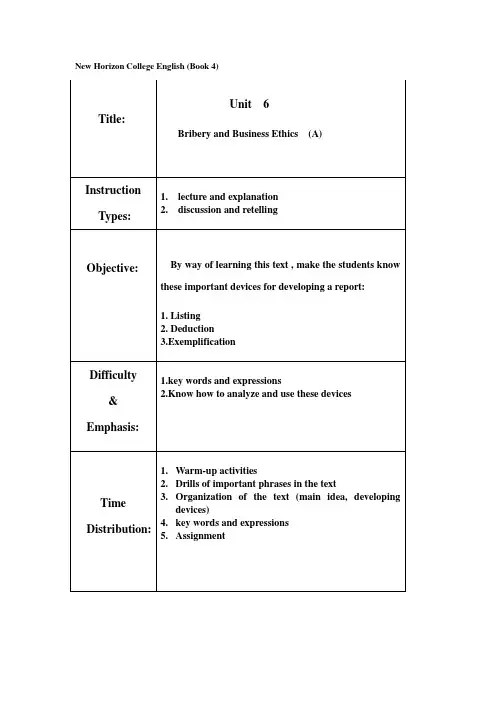
New Horizon College English (Book 4)I. Warm-up activities1.Background informationChrysler Corporation (A)The Chrysler Corporation, founded in 1924, used to be one of the three largest American automobile manufacturers whose brands include both passenger and commercial vehicles such as Chrysler, Jeep® and Dodge. The two other largest American automobile manufacturers are General Motors and Ford.Chrysler Corporation (B)In addition to auto making, Chrysler is also engaged in financial services, providing loan services (mostly) to car buyers. In 1998 it merged with Daimler-Benz AG (of Germany) (best known for its Mercedes-Benz brand name) to become part of the DaimlerChrysler Corporation, which is jointly owned by European, U.S. and other international investors.U.S. Securities and Exchange Commission (SEC) (A)A U.S. government agency, whose mission is to protect investors and maintain the integrity of the securities markets. The Commission was set up by the U.S. Congress in 1933 in response to “Black Monday”, the Great Stock Market Crash in 1929.U.S. Securities and Exchange Commission (SEC) (B)Its purpose was to restore investor confidence in the U.S. capital markets by providing more structure and government oversight. It is based on the concept that all investors, whether large institutions or private individuals, should have access to certain basic facts about an investment prior to buying it. To achieve this, the SEC requires public companies to disclose meaningful financial and other information to the public, which provides a common pool of knowledge for all investors to use to judge for themselves if a company’s securities are a good investment.U.S. Securities and Exchange Commission (SEC) (C)It is believed that only through the steady flow of timely, comprehensive and accurate information can people make sound investment decisions. At present the SEC is comprised of five presidentially-appointed Commissioners, four Divisions and 18 Offices, with a total of about 3,100 staff.The International Chamber of Commerce (A)The aim of the International Chamber of Commerce (ICC), founded in 1919, is to serve world business by promoting trade and investment, open markets for goods and services, and the free flow of capital.The International Chamber of Commerce (B)Its activities cover a broad spectrum, from arbitration and dispute resolution to making the case for open trade and the market economy system, business self-regulation, fighting corruption or combating commercial crime. The ICC is made of a World Council (its governing body) and individual national committees and groups. Individual companies, corporations, professional associations as well as individuals can also join the ICC as individual members.2.Questions and answers1)-Why do business students study professional ethics?People feel that bribery is increasing throughout the world. One day, business students will grow into managers of all ranks and in all fields. If they should offer or take bribes in their positions, corruption and unfair competition would result. In that case, normal economic order would be ruined, and people in business circles would have no commonly agreed principles to follow. Toprevent this, business students are now required to study professional ethics as part of their course.2)-Why do the people in the motor industry have to give bribes or extra discounts?People in the motor industry argue that the market is very competitive. If they don’t give bribes to make the customers happy, one of their rivals will. And, as a result, they are likely to lose their share of market, which is unacceptable to both the salespeople and the company.3)-Why do some members of the ICC probably feel the code of conduct should not be legally enforceable?Some members of the ICC feel that it is not the business of the ICC to enforce the code of conduct. They believe that government should make and impose it, and the job of the ICC is only to state what is right and what is wrong in conducting business.II.Drills of important phrases in the text1. 在增长中on the increase (L. 3)2. 明确向某人表示;明确告知某人make it clear to sb. that… (L. 6)3. 坚持原则stand by one’s principles (L. 8)4. 有高尚的道德标准have high moral standards (L. 9)5. 私下里;秘密地;在私生活里;在家里in private (L. 15)6. 为方便讨论起见/为了政治目的for discussion/political purposes (L. 30/32)7. 正在调查中under investigation (L. 34)8. 因可能触犯商业法规for possible violations of business laws (L. 35)9. 资助某人做某事finance sb.’s efforts to do sth. (L. 36)10. 得到主要建筑合同secure major construction contracts (L. 38)11. 给······施加压力/过分强调······put pressure/undue stress on... (L. 41)12. 向某人捐款/汇款make donations/payments to sb. (L. 42)13. 加快······速度speed up the wheels/progress of… (L. 44)14. 想出了办法hit upon/on the answer/solution (L. 46)15. 暗中将某物塞入······slip sth. into/within… (L. 47)16. 属于此类be included on this list (L. 55) 17. 设计一套法规devise a code of rules (L. 56)18. 禁止各种类型的贿赂prohibit bribery in various forms/in all its forms (L. 3/56)19. 达到; 等于; 实际上是amount to (L. 59) 20. 既确保自己的利益,又无愧道德良心s quare one’s interests with his moral conscience (L. 68)anization of the text (main idea, developing devices)1.Main idea of the textBribery in various forms is on the increase and has become a fact of commercial life. On the whole, the bribery can fall into three categories: for political purposes or to secure major contracts; to obtain quicker official approval of some projects; and to obtain help with the passage of a business deal. To ban bribery, ICC favors a code of conduct. However, the ICC members are of different opinions. The headache is still there to stay in business.2.How is the text organized?The passage is broadly put into three parts: bribery has become a common occurrence in many countries, three main categories of bribery, and the efforts to ban bribery and the result. The whole passage is organized in problem-solution pattern. In the first part, the phenomenon (the problem) is described; in the second, the questionable payments are analyzed; and in the third, the efforts forsolution and the result are presented.The illustration of the problem (Paras. 1-4)Bribery is a common occurrence in many countries. The phenomenon is introduced by “classes on business ethics”, and exemplified by two examples: a British car manufacturer and the Chrysler Corporation.The analysis of the problem (Paras. 5-8)Questionable payments can be divided into three categories: 1. Those for political purposes or to secure major contracts; 2. Those for obtaining quicker official approval of some projects; 3. Those for help with the passage of a business deal.The solution of the problem (Paras. 9-11)ICC is to set up a code of conduct that would ban the giving and seeking of bribes. And a council has been proposed to manage the code. However, opinions differ among the members of ICC. Bribery seems inevitable.3.Text analysisPart I: ( para. 1-4 ):Bribery is a common occurrence in many countries.Part II: ( para 5– 8) :Three broad categories of bribes.Part III: ( para. 9 – 161) :Efforts made by ICC to ban bribery.IV. key words and expressionsA. Expressions1.to put pressure/undue stress on... (L. 41)给······施加压力/过分强调······Eg:Putting undue stress on book knowledge will weaken students’ enthusiasm for creative thinking.过分强调书本知识会削弱学生创造性思维的热情。

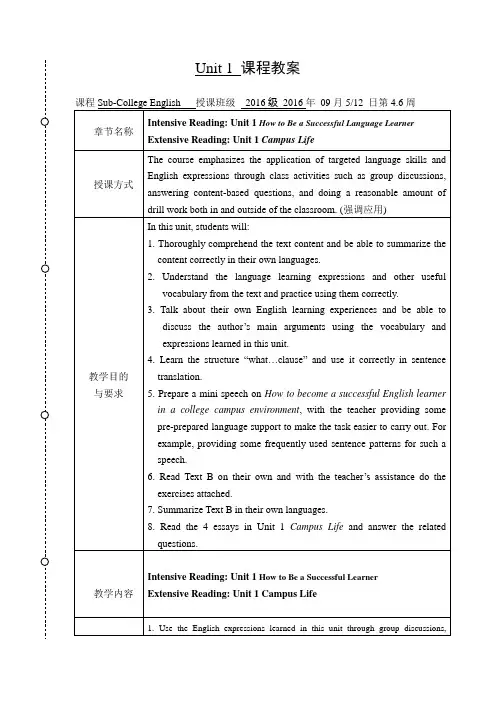
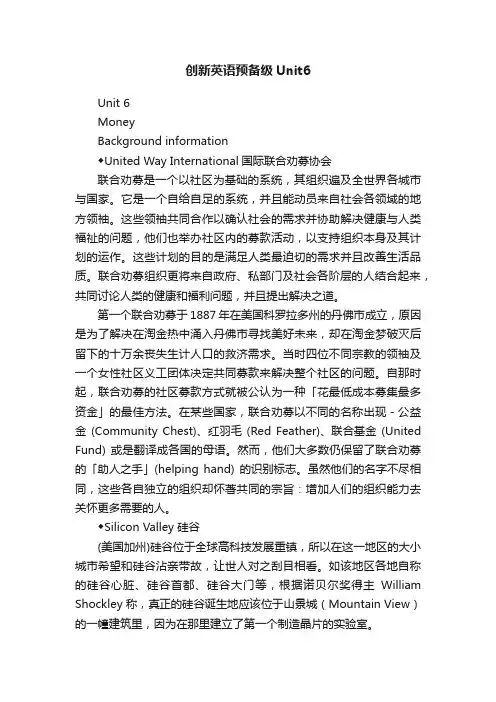
创新英语预备级Unit6Unit 6MoneyBackground information◆United Way International国际联合劝募协会联合劝募是一个以社区为基础的系统,其组织遍及全世界各城市与国家。
它是一个自给自足的系统,并且能动员来自社会各领域的地方领袖。
这些领袖共同合作以确认社会的需求并协助解决健康与人类福祉的问题,他们也举办社区内的募款活动,以支持组织本身及其计划的运作。
这些计划的目的是满足人类最迫切的需求并且改善生活品质。
联合劝募组织更将来自政府、私部门及社会各阶层的人结合起来,共同讨论人类的健康和福利问题,并且提出解决之道。
第一个联合劝募于1887年在美国科罗拉多州的丹佛市成立,原因是为了解决在淘金热中涌入丹佛市寻找美好未来,却在淘金梦破灭后留下的十万余丧失生计人口的救济需求。
当时四位不同宗教的领袖及一个女性社区义工团体决定共同募款来解决整个社区的问题。
自那时起,联合劝募的社区募款方式就被公认为一种「花最低成本募集最多资金」的最佳方法。
在某些国家,联合劝募以不同的名称出现-公益金(Community Chest)、红羽毛(Red Feather)、联合基金(United Fund) 或是翻译成各国的母语。
然而,他们大多数仍保留了联合劝募的「助人之手」(helping hand) 的识别标志。
虽然他们的名字不尽相同,这些各自独立的组织却怀著共同的宗旨:增加人们的组织能力去关怀更多需要的人。
◆Silicon Valley 硅谷(美国加州)硅谷位于全球高科技发展重镇,所以在这一地区的大小城市希望和硅谷沾亲带故,让世人对之刮目相看。
如该地区各地自称的硅谷心脏、硅谷首都、硅谷大门等,根据诺贝尔奖得主William Shockley 称,真正的硅谷诞生地应该位于山景城(Mountain View)的一幢建筑里,因为在那里建立了第一个制造晶片的实验室。
高科技产业员工选择在硅谷工作及企业选择在当地投资的重要因素之一是因为当地美丽自然的环境所带来的高品质生活以及清新的企业形象,另外也是当地的高等学府所带来的技术转移。
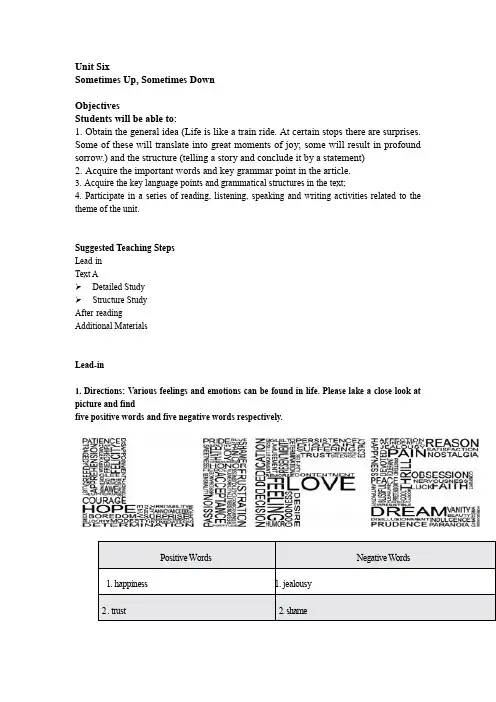
Unit SixSometimes Up, Sometimes DownObjectivesStudents will be able to:1.Obtain the general idea (Life is like a train ride. At certain stops there are surprises. Some of these will translate into great moments of joy; some will result in profound sorrow.) and the structure (telling a story and conclude it by a statement)2.Acquire the important words and key grammar point in the article.3.Acquire the key language points and grammatical structures in the text;4. Participate in a series of reading, listening, speaking and writing activities related to the theme of the unit.Suggested Teaching StepsLead-inText A➢Detailed Study➢Structure StudyAfter-readingAdditional MaterialsLead-in1.Directions: Various feelings and emotions can be found in life. Please lake a close look at picture and findfive positive words and five negative words respectively.2. Directions: Please fill in your understanding of life.“Good friends, good books, and a sleepy conscience: this is the ideal life."— Mark Twain What is your understanding of life?, , and : this is the ideal life.3. Directions: Listen to a poem about life and fill in the blanks.Life is too short to wake up in the morning with regrets.So, love the people who treat you right and forget about the ones who don't.And believe that everything happens for a reason.If you get a chance — take it;If it changes your life — let it;Nobody said that it would be easy.They just promised it would be worth it.Text A Life is like a Train RideLife is like a train ride. We get on. We ride. We get off. Wget back on and ride some more. There are accidents and there are delays. At certain stops there are surprises. Some of these will translate into great moments of joy; some will result in profound sorrow.When we are born and we first board the train, we meet people whom we think will be with us for the entire journey. Those people are our parents! Sadly, this is far from the truth. Our parents are with us for as long as we absolutely need them. They, too, have journeys they must complete. We live on with the memories of their love, affection, friendship, guidance and their constant presence.There are others who board the train and who eventually become very important to us, in turn. These people are our brothers, sisters, friends and acquaintances, whom we will learn to love, and cherish.Some people consider their journey like a jaunty tour. They will just go merrily along. Others will encounter many upsets, tears and losses on their journey. Others still, will linger on to offer a helping hand to anyone in need.Some people on the train will leave an everlasting impression when they get off. Some will get on and get off the train so quickly; they will scarcely leave a sign that they ever travelled along with you or ever crossed your path.We will sometimes be upset that some passengers,whom we love, will choose to sit in another compartment and leave us to travel on our own. Then again, there’s nothing that says we can’t seek them out anyway. Nevertheless, once we have found them, we may not even be able to sit next to them because that seat will already be taken.That’ OK…everyone’s journey will be filled with hopes, dreams, challenges, setbacks and goodbyes.We must strive to make the best of it. No matter what. We must constantly strive to understand our travel companions and look for the best in everyone.Remember that at any moment during our journey, any one of our travel companions can have a weak moment and be in need of our help. We too may hesitate, even trip. Hopefully, we can count on someone being there to be supportive and understanding.The bigger mystery of our journey is that we don’t know when our last stop will come. Neither do we know when our travel companions will make their last stop. Not even those sitting in the seat next to us. Personally, I know I’ll be sad to make my final stop. I’m sure of it! My separation from all those friends and acquaintances I made during the train ride will be painful. Leaving all those I’m close to will be a sad thing. But then again, I’m certain that one day I’ll get to the main station only to meet up with everyone else. They’ll all be carrying their baggage, most of which they didn’t have when they first got on.I’ll be glad to see them again. I’ll also be glad to have contributed to their baggage and to have enriched their lives, just as much as they will have contributed to my baggage and enriched my life.We’re all on this train ride together. Above all, we should all strive to make the ride as pleasant and memorable as we can, right up until we each make the final stop and leave the train for the last time.All aboard!Safe journey!Bon voyage!Detailed Study1. (Para. 1) Some of these will translate into great moments of joy; some will result in profound sorrow.【译文】或化作片刻欢悦,或以铭心悲痛收场。
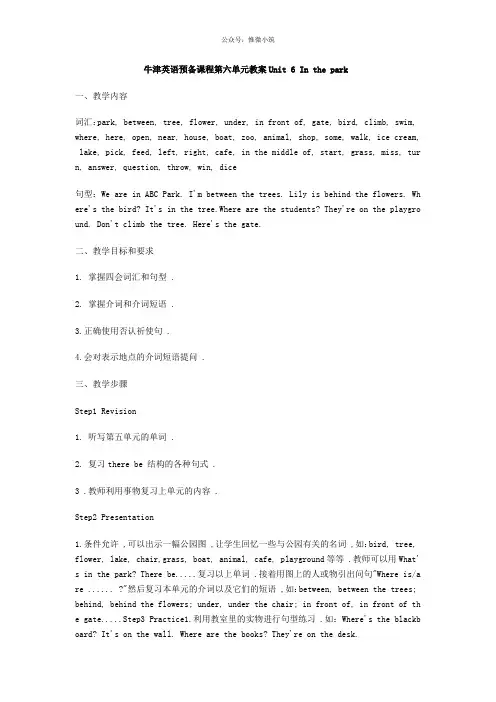
牛津英语预备课程第六单元教案Unit 6 In the park一、教学内容词汇:park, between, tree, flower, under, in front of, gate, bird, climb, swim, where, here, open, near, house, boat, zoo, animal, shop, some, walk, ice cream, lake, pick, feed, left, right, cafe, in the middle of, start, grass, miss, tur n, answer, question, throw, win, dice句型:We are in ABC Park. I'm between the trees. Lily is behind the flowers. Wh ere's the bird? It's in the tree.Where are the students? They're on the playgro und. Don't climb the tree. Here's the gate.二、教学目标和要求1. 掌握四会词汇和句型 .2. 掌握介词和介词短语 .3.正确使用否认祈使句 .4.会对表示地点的介词短语提问 .三、教学步骤Step1 Revision1. 听写第五单元的单词 .2. 复习there be 结构的各种句式 .3 .教师利用事物复习上单元的内容 .Step2 Presentation1.条件允许 ,可以出示一幅公园图 ,让学生回忆一些与公园有关的名词 ,如:bird, tree, flower, lake, chair,grass, boat, animal, cafe, playground等等 .教师可以用What' s in the park? There be.....复习以上单词 .接着用图上的人或物引出问句"Where is/a re ...... ?"然后复习本单元的介词以及它们的短语 ,如:between, between the trees; behind, behind the flowers; under, under the chair; in front of, in front of th e gate.....Step3 Practice1.利用教室里的实物进行句型练习 .如:Where's the blackb oard? It's on the wall. Where are the books? They're on the desk.2. 做听力复习否认祈使句的构成 ,并利用本课的动词做口头练习 .四、知识讲解1.in, on, under, behind的含义:in表示 "在……里面〞 ,on表示两者接触 "在……上面〞 ,under表示不接触 "在……下方〞 ,behind表示 "在 (外面的 )后面〞 .2.between 的意思是 "在......之间〞 ,后面应该跟名词复数 .如:between the trees, between the bags3.in thetree 与on the tree 都是 "在树上〞 ,但前者指不是树本身具有的 ,而是通过其他途径 (如爬行、飞等 )而到了树上 .如:My kite is in the tree.(我的饿风筝在那棵树上 . )There is a ball in the tree.(树上有个秋 . )后者指树本身具有的 ,on 强调接触 .如:There are some bananas on the tree.(树上有些香蕉 . )4. in front of / in the front of 都表示 "在....前面〞 ,但从人所处的位置来讲 ,它们有着很大的区别 .in front of 表示在一物体外部的前面或正前方 ,即 "在......前面〞的意思 .例如:There are some big trees in front of the workshop.(车间的前面有几棵大树 . )in the front of 表示 "在.....前部〞的意思 ,常有内外之别 .如:The re is a big blackboard in the front of the classroom.(教室前面有个大黑板 . )5. on the left 与on the right 分别指 "在左边〞和 "在右边〞 ,但是如果想表达 "在......左边或右边〞 ,需要在后面加of ,类似的词有in the middle ( of ).6. Where's...?及其答复 .如要询问某物或某人在哪里 ,可能 "Where is...?〞这一句型 .这一问句的结构与中文完全不同 ,where一词的意思是 "在哪里〞 .例如:Where's your p en? It's here. Where is your book? It's here. Where is your teacher?这是一个特殊问句 ,答复时不能用Yes或No答复 ,而应直接答复 .It (He...) is......五、能力训练1. 翻译词组 .(1 )在树之间__________ (2 )在大门前__________ (3 )在椅子下面__________ (4 )在操场上__________ (5 )在学校左侧__________ (6 )在公园(中|央)__________2. 用适空 .(1) __________is your pen? It's__________ my pencil -box.(2) Where __________my pencils? They're on __________ desk.(3) Where __________ the picture? It's __________the wall.(4) Where__________ the balls? They're __________the floor.3.用what, where, how填空 .(1)__________ are you? I'm fine.(2)__________is my bag? It's here.(3)__________ is this? It's a book.(4)__________ grade are you in? I'm in Grade 1.4.英汉互译 .(1)我在八班_______________________(3) I'm in Class 4. _______________________(4)早上好 ,|王老师 ._______________________(5)三支钢笔_______________________(6)这些苹果_______________________5. 句型转换 .(1) Lucy's coat is on the desk. (对斜体局部提问 )________________________(2) My name is Liu Tao. (同上 )__________________________________________(3) My teacher is thirty. (同上 )__________________________________________(4) The maps are on the wall. (同上 )__________________________________________(5) My bag is on the chair. (同上 )__________________________________________(6) They are in her pencil -box. (改一般疑问句 )_________________________(7) is, big, there, behind, cafe, a, the. (连词成句 )__________________________ ___(8) There are some flowers in the park.. (改一般问句并作否认答复 )_____________ __(9) Pick the flowers. (改否认句 )__________________________________________(10) There are two toilets on the left of the gate. (对斜体提问 )______________ ___6. 完成以下对话 .A: Jill, there __________a new park near my school.B: Oh, that's nice. What's in it? __________there any lakes?A: No, there __________, but there__________a zoo.B:__________there many, and there__________ lots of small animals, too.A: What about shops?B: There __________some small shops near the park7. 翻译以下句子 .(1 )他在树之间 .__________________________________________(2 )那个男孩在门后面 .__________________________________________(3 )在公园不要爬树 .__________________________________________(4 )她在我家门前 .__________________________________________(5 )操场上有许多男孩和女孩 .__________________________________________。
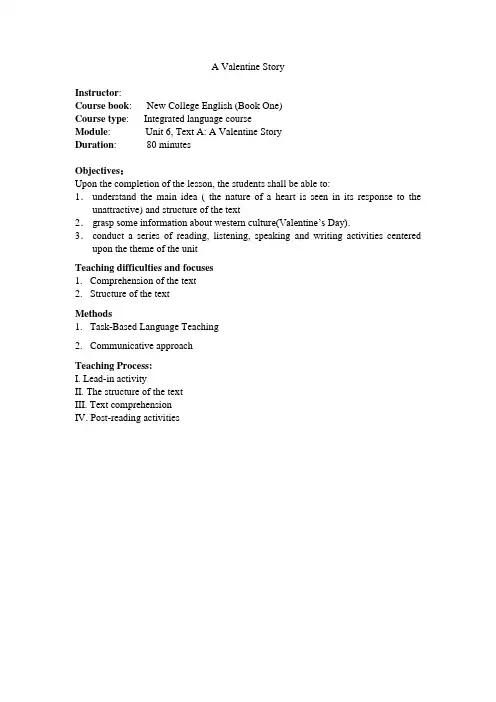
A Valentine StoryInstructor:Course book: New College English (Book One)Course type: Integrated language courseModule: Unit 6, Text A: A Valentine StoryDuration:80 minutesObjectives:Upon the completion of the lesson, the students shall be able to:1.understand the main idea ( the nature of a heart is seen in its response to the unattractive) and structure of the text2.grasp some information about western culture(Valentine’s Day).3.conduct a series of reading, listening, speaking and writing activities centered upon the theme of the unitTeaching difficulties and focusesprehension of the text2.Structure of the textMethods1.Task-Based Language Teachingmunicative approachTeaching Process:I. Lead-in activityII. The structure of the textIII. Text comprehensionIV. Post-reading activitiesStep I Lead-in activity1. Background information about the Valent ine’s Day2. Students are required to talk about the love stories they have or they know.Step II The structure of the textStep III. Text comprehension1. Read Part 1 carefully and answer the following questions.1). What do you think is the reason that John Blanchard came to the Grand CentralStation?2). Who do you think he was waiting for?3). Why did he straighten his uniform?2. Read Part 2 carefully and supply the missing information.1). Taking a book off the shelf he____________________________.2). With time and effort he__________________________________.3). I’d always be haunted by the feeling that you_________________.4). A girl he had never seen, yet whose written words_____________.3. Read Part 3 carefully and choose the best answer for each question.1). Who was coming toward Blanchard?A) A middle-aged woman.B) A young beautiful ladyC) A worn-out soldier.D) A lively and naive pupil.2). The young lady was dressed in________.A)the red suitB)the yellow suitC)the blue suitD)the green suit3). How old was the “supposed” Hollis Maynell?A) Over 20.B) Over 30 .C) Over 40 .D) Over 50 .4). While he spoke Blanchard felt choked by the bitterness of his _____________.A) disappointmentB) happinessC) excitementD) enjoyment5). How come the middle- aged woman was wearing the rose?A) The middle- aged woman was Miss Maynell.B) The middle- aged woman happened to wear the rose.C) The real Miss Maynell begged her to wear the rose on her coat to testBlanchard.D) Miss Maynell didn’t want to see Blanchard.6). Why did Miss Maynell ask the middle-aged woman to act as her?A) It was a joke.B) It was a sense of humor.C) It was April Fool’s Day.D) It was some kind of test.4. Read Part 4 carefully and answer the following questions.1). What did Miss Maynell want to find out through the test?2). How do you understand Houssaye’s remark “tell me whom you love, and I willtell you who you are”?5. Rearrange the following sentences in a logical order according to the text.a. A woman well past 40 appeared, wearing a rose which was used to identify thegirl Hollis Maynell.b. John Blanchard went to the woman and asked the woman out to dinner.c. They scheduled their first meeting in Grand Central Station.d. John Blanchard’s interest in Hollis Maynell had begun twelve months before in aFlorida library.e. The woman told John Blanchard that it was the young lady in the green suit whohad asked her to do so.Step IV. Post-reading activitiesStudents are required to have a role play on this valentine story and try to perform the following verbal phrases as many as possible.have one’s face broaden into a smile stand up from one’s seat straighten one’s clothes stand directly behind sb..make one step closer to sb. start toward sbsquare one’s shoulders hold out a bookhold out a book to sb. grip a book。
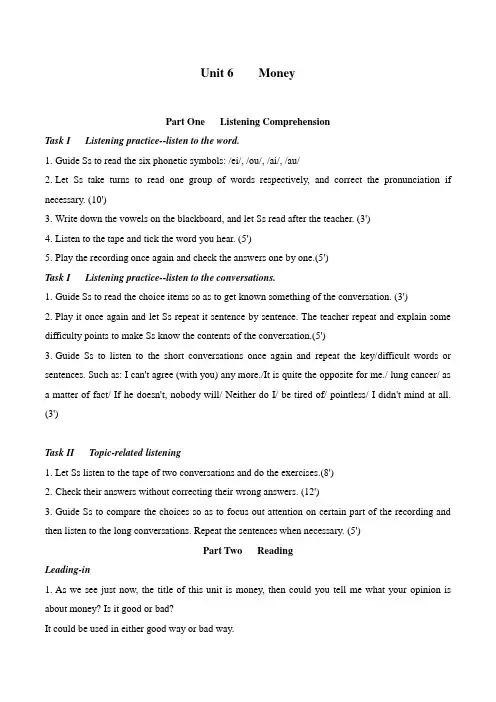
Unit 6 MoneyPart One Listening ComprehensionTask I Listening practice--listen to the word.1.Guide Ss to read the six phonetic symbols: /ei/, /ou/, /ai/, /au/2.Let Ss take turns to read one group of words respectively, and correct the pronunciation if necessary. (10')3.Write down the vowels on the blackboard, and let Ss read after the teacher. (3')4.Listen to the tape and tick the word you hear. (5')5.Play the recording once again and check the answers one by one.(5')Task I Listening practice--listen to the conversations.1.Guide Ss to read the choice items so as to get known something of the conversation. (3')2.Play it once again and let Ss repeat it sentence by sentence. The teacher repeat and explain some difficulty points to make Ss know the contents of the conversation.(5')3.Guide Ss to listen to the short conversations once again and repeat the key/difficult words or sentences. Such as: I can't agree (with you) any more./It is quite the opposite for me./ lung cancer/ as a matter of fact/ If he doesn't, nobody will/ Neither do I/ be tired of/ pointless/ I didn't mind at all. (3')Task II Topic-related listening1.Let Ss listen to the tape of two conversations and do the exercises.(8')2.Check their answers without correcting their wrong answers. (12')3.Guide Ss to compare the choices so as to focus out attention on certain part of the recording and then listen to the long conversations. Repeat the sentences when necessary. (5')Part Two ReadingLeading-in1.As we see just now, the title of this unit is money, then could you tell me what your opinion is about money? Is it good or bad?It could be used in either good way or bad way.2.Do you like money? What its importance in our daily life?It is very crucial for our necessities.3.Do you think that money could do any thing? Why?Yes, it is the basic part in our life. / No, it is less important than love and family.Task I Reading Comprehension—How Poor Are We?1.Ask Ss to close their books and tell them they will get a story. Read the passage loudly andslowly. Write the key points or difficult words on blackboard so that they can fully understand the story. Pause to give explanation when necessary.2.Ask Ss to finish the multiple choices.3.Suggest Ss to recite the words said by the son and the last two paragraphs and told them they willrecite them the next period.Task I Reading Comprehension—Expensive Cities1.Ask Ss to read the passage and try to find the answers to the questions. Advise them to read thequestions first so as to focus their attention on certain sentences while reading.2.Guide Ss to find the places where they can find the answers and check the answers.3.Difficult words or points.Tokyo 东京Osaka 大阪Berlin 柏林Buenos Aires 布宜诺斯艾莉斯Tehran 德黑兰Iran 伊朗Harare 哈拉雷Zimbabwe 津巴布韦Task II Fast Reading—The Good-deed Doers1.Read the statements in the exercise so as to focus the attention on the relevant sentences.2.Let Ss read the passage in a limited time and finish the exercise, try to apply the reading skill,like skimming and scanning.3.Guide Ss to read through the passage and translate the last 3 paragraphs.Translation:第六段:我的理由是:很多人都比你值钱得多,而且要在硅谷的大慈善家名单上榜上有名比成为硅谷的富豪之一要容易得多,那为什么我们不努力成为我们力所能及的前十呢?第七段:我美好得憧憬着或许有那么一天,人们投资慈善事业就像他们投资网络公司那样充满热情,那时候他们发现慈善事业是很有效的,他们还可能别人不用请求,自己主动多捐些钱呢!比如说,慈善组织说:“你可能为我们捐献一万美金?”人们回答说:“好啊,给五万行不行?因为事实上问题比你认为的要严重的多呢,所以你要提前考虑些意外因素嘛。
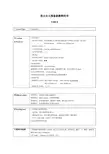
昂立少儿预备级教师用书Unit 6Ⅰ Lesson Type:CompositiveⅡContents & Purposes:1.Sentences:新句学习内容:16.Suddenly, an old man appeared. 17.What’s wrong,my boy?18.I lost my ax. 19.Don’t cry. I’ll help you.新句学习目的:☆句子扩展内容:I lost my ax/book/money.句子扩展目的:☆☆2.Words:新词学习内容:appear, money, book, old man,新词学习目的:★★3.Song/Chant:新教授歌曲内容:Good morning.新歌曲学习目的:提高学习兴趣,活跃课堂气氛,复习巩固已学chant。
运用已学律动内容:Good morning.已学律动学习目的:由已学的律动引出歌曲的教学4.段落扩展:新段落学习内容:Boy: What’s wrong?Girl: I lost my money/book.Boy: I’ll help you. Girl: Thank you.新段落学习目的:☆☆☆ⅢDifficult points:语音难点:suddenly, help, appeared理解难点:what’s wrong …?的情景理解态度难点:在表演故事时,能够投入剧情,模仿老人的声音;情绪难点:注意鼓励男孩子的参与意识;ⅣTeaching tools 1.已有教具使用和目的:录音带: 用于课前带读,复习;教师挂图16-6:用于课堂背景渲染,创设语言情景,课堂教学斧子,巫师斗篷,白胡子:用于课堂表演2.自备道具和使用目的,Ⅴ竞争计分机制 1.贯彻整堂课的奖励计分机制:两个小女孩的头像,流着眼泪,赢的一方,擦掉一滴眼泪。
操练Don’t cry. I’ll help you.2.在Input ,Practice (环节)使用:左右VI Teaching procedures:1、Warming up: (3 m’)1. Review the chant “good morning”集体表演,分两部分表演(像对山歌样的问候)Good morning, everybody! Before our class, I’ll call the roll! Good morning, ##!Ok, group1 and group2 face to face! Now let’s say “good morning”to each other! Show me your power!2 Review and develop: (5 m’)1. Review the story, read after T.2. I do you say.3. Little Interpreter 看图造句3、New sentences / text:(39 m’)Fairy Tale内容:16. Suddenly, an old man appeared. 17.What’s wrong,my boy?18. I lost my ax. 19. Don’t cry. I’ll help you.步骤:A、新课导入:(3 m’)First, T and S perform together; then, T takes out the new picture16-6, saying: ‘Suddenly, an old man appeared! Oh, what happened to the old man and the boy? Guess!”B、Input:(6 m’) 1.T performs the new text slowly ( wear the old man’s clothes, and the beard )Suddenly, an old man appeared. (跟着老师做魔法师出现的动作,给模仿的好的学生上台,穿上这套服装,背向台下学生蹲好,老师说出句子,学生表演出来)2. Perform together! (just do it)C、Practice 1.Suddenly, an old man appeared.1)难点发音:appeared/suddenly2)突破方法:Appeared: follow me-----flash card (a fan , one side of it is picture--appeared, andthe other side is a blank page--disappeared, )Suddenly: follow me---- Magic fingers3)操练对象范围:together4)预计使用竞争机制:2.What’s wrong,my boy?1)难点:What’s wrong2)突破方法:make a situation----high and low voice----3. I lost my ax.1)难点发音:lost2)突破方法:follow me----traffic lights4.Don’t cry. I’ll help you.1)难点发音:help2)突破方法:follow me----traffic lights----make a situationD、Output:(time)检查输出的形式:面:plete my sentence2.I do you say.3.Numbers and sentences片:Dragon. Tell the story one by one, and each student say one sentence.点:Role play(2~3组)4、Fun time 选用chant:Good Morning进行律动的比赛,将学生分成两组,面对面站,集体表演律动,选出最整齐合拍的组。
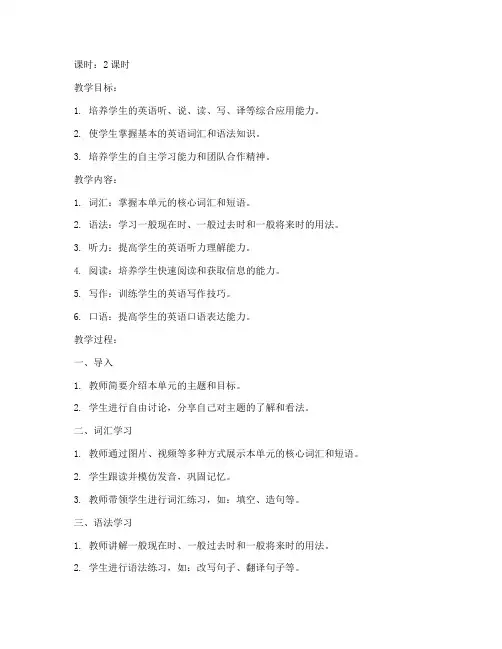
课时:2课时教学目标:1. 培养学生的英语听、说、读、写、译等综合应用能力。
2. 使学生掌握基本的英语词汇和语法知识。
3. 培养学生的自主学习能力和团队合作精神。
教学内容:1. 词汇:掌握本单元的核心词汇和短语。
2. 语法:学习一般现在时、一般过去时和一般将来时的用法。
3. 听力:提高学生的英语听力理解能力。
4. 阅读:培养学生快速阅读和获取信息的能力。
5. 写作:训练学生的英语写作技巧。
6. 口语:提高学生的英语口语表达能力。
教学过程:一、导入1. 教师简要介绍本单元的主题和目标。
2. 学生进行自由讨论,分享自己对主题的了解和看法。
二、词汇学习1. 教师通过图片、视频等多种方式展示本单元的核心词汇和短语。
2. 学生跟读并模仿发音,巩固记忆。
3. 教师带领学生进行词汇练习,如:填空、造句等。
三、语法学习1. 教师讲解一般现在时、一般过去时和一般将来时的用法。
2. 学生进行语法练习,如:改写句子、翻译句子等。
四、听力训练1. 教师播放听力材料,学生认真听并记录关键信息。
2. 学生回答听力问题,教师点评并纠正错误。
3. 学生复述听力内容,提高口语表达能力。
五、阅读训练1. 教师讲解阅读技巧,如:快速浏览、定位信息等。
2. 学生阅读课文,找出关键信息。
3. 教师提问,检查学生的阅读理解能力。
六、写作训练1. 教师讲解写作技巧,如:段落结构、句子连接等。
2. 学生根据课文内容进行写作练习,如:写一篇短文。
3. 教师点评学生的写作,指出优点和不足。
七、口语训练1. 学生分组进行口语练习,如:角色扮演、辩论等。
2. 教师巡视指导,纠正发音和语法错误。
3. 学生展示练习成果,互相学习、交流。
八、总结与作业1. 教师对本节课的学习内容进行总结,强调重点和难点。
2. 布置课后作业,如:复习课文、预习下一课等。
教学评价:1. 课堂参与度:观察学生在课堂上的发言、互动情况。
2. 作业完成情况:检查学生的课后作业,了解学生的学习效果。
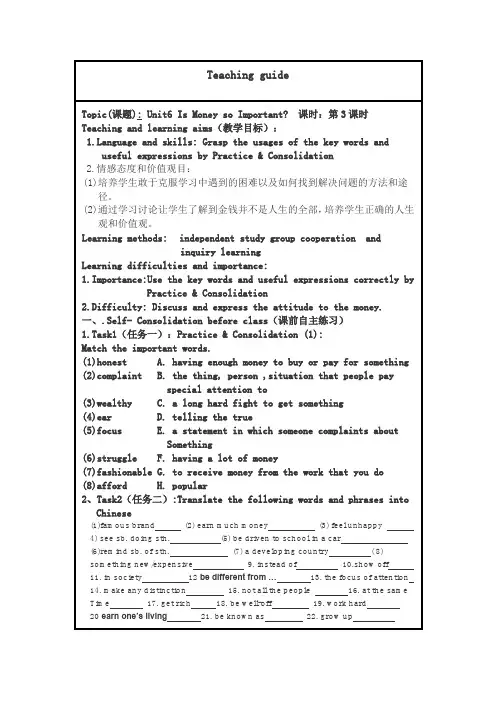
Unit6 Is Money So Important?说课稿首先我要感谢学校,学部及英语组的领导和同事们给了我这个千载难得的机会。
下面我将简要的说一下自己的这一堂课。
我设计的这节课选自高一对口英语基础模块下册unit6 Reading部分。
教学目标是①掌握本单元的重要短语句型。
②训练学生的阅读能力。
③独立完成相关练习。
重点是:理解课文,难点是掌握课文中重要句子中包含的语法点(短语、句型),总的教学流程是:复习→导入→快速阅读→精读→反馈练习→作业。
导入部分是学生在我的领导下自己编排制作的一个小插曲(节目),目的是既能导出本单元的课题,又能以一开始就吸引学生的注意力,使本课能以轻松、愉悦的基调打开。
快速阅读(Fast reading)和精读(Intensive reading)部分以小组活动,学生自主讲解、展示的形式,完成里面的相关问题,反馈练习部分是学生在前面Fast reading,尤其是Intensive reading的基础上设计的有针对性的一些练习,由全体学生独立完成,之后仍是学生主导核对自己的答案和重点强调。
本节课学生是主导是主角,我只在一些个别场合引导和强调一下,基本上想的是把上课的主动权交给学生,走出传统课堂,但是基于对口班学生的英语基础的影响,在展示过程中出现了一些小问题。
如:1、展示过程中学生的发音问题;2、Fast reading task2里展示小组同学们没有利用上自己的版面;3、Intensive reading里同学们一起复习环节,我设计的是同学们一起读,通过齐读来再次复习和记忆一遍本课的知识点,可能是下面的同学没有领会小主持人的意思,变成了跟读,一半之后我进行了纠正,改为齐读;4、展示的同学强调知识点时,依然有个别同学不能跟着画出来,做笔记;5、参与展示的同学声音不够洪亮;6、设置了小组活动,但是没有小组计分、评价。
基于英语学科的特殊性及对口班学生英语基础较差的现实性。
教学目标:1. 理解和掌握Unit 6的主题,即“如何进行有效的沟通”。
2. 培养学生运用英语进行有效沟通的能力,提高口语和写作水平。
3. 增强学生的团队协作意识,提高团队沟通能力。
教学重点:1. 熟练掌握Unit 6中的核心词汇和短语。
2. 掌握有效的沟通技巧和方法。
3. 学会运用英语进行有效的团队沟通。
教学难点:1. 如何在课堂上激发学生的学习兴趣,提高课堂参与度。
2. 如何帮助学生克服沟通障碍,提高沟通能力。
教学准备:1. 教学课件:包括课文内容、核心词汇、短语和练习题。
2. 团队合作道具:如卡片、彩笔等。
教学过程:一、导入1. 用英语提问:“How do you communicate with others in your daily life?”引导学生思考沟通的重要性。
2. 引入Unit 6主题:“In this unit, we will learn how to communicate effectively.”二、课文讲解1. 介绍课文背景和作者。
2. 讲解课文中的核心词汇和短语,如:effective communication、active listening、non-verbal communication等。
3. 分析课文中的沟通技巧和方法,如:如何倾听、如何表达、如何处理冲突等。
三、互动环节1. 分组讨论:将学生分成若干小组,每组讨论如何运用课文中的沟通技巧和方法解决实际问题。
2. 小组展示:每组选派一名代表,用英语展示小组讨论成果。
四、实践环节1. 角色扮演:模拟实际场景,如面试、商务谈判等,让学生运用所学知识进行沟通。
2. 模拟游戏:设计一个团队协作游戏,让学生在游戏中体会沟通的重要性。
五、总结与作业1. 总结本节课的重点内容,强调沟通技巧的重要性。
2. 布置作业:让学生写一篇关于如何进行有效沟通的短文,字数不少于300字。
教学反思:1. 本节课通过多种教学手段,如讨论、角色扮演等,激发了学生的学习兴趣,提高了课堂参与度。
Innovation English Integrated Course Book 4Unit SixMade in ChinaObjectivesStudents will be able to:1. Grasp the main idea and structure of the text2. Acquire the key language points and grammatical structures in the text;3. Participate in a series of reading, listening, speaking and writing activities related to the theme of the unit. Suggested Teaching StepsLead-inText A➢Word Study➢Sentence Study➢Structure StudyAfter-readingAdditional MaterialsLead-inDirections: Please watch the video clip and answer the questions.l. What examples are given in the video as “Made-in-China”?Tips: shovel, Huawei cell phone, high-speed railway, super computer, shared bikes, etc.2. According to the video, what did “Made in China” used to mean? And what does it represent nowadays?Tips: “Made in China” used to be used in a pejorative sense to denote low-end, handmade products, produced at meager cost and sold equally cheaply. However, today, “Made in China” is a symbol of high-quality products at reasonable prices, demonstrating the comprehensive and powerful capacity of China’s manufacturing industry.Text A: Going Global: Chinese Firms AbroadAmid the torrent of clothes, electronics and toys surging out of China comes a little noticed export: international companies.For centuries, individual Chinese have sought their fortunes abroad, creating Chinatowns around their restaurants and shops. Now, Chinese firms are going global, pushed by government economic policies, pulled by untapped markets and armed with bundles of money from a thriving economy back home.Auto plants are popping up in Latin America. A sprawling commodity bazaar promises a provincial Swedish city new life. A car parts distributor is snapping up ailing companies in the U.S. Rust Belt, a TV factory hums in South Africa and a high-tech firm is contracts to revamp the Persian Gulfs networks.Just as the earlier arrival of Japanese companies changed U.S. manufacturing, over time Chinese companies could affect how their western rivals approach innovation, competition and business itself.“We not only consider ourselves pioneers,” says Sean Chen, who at 26 is overseeing the construction of a $ l00 million electrical parts plant and industrial park in the American south. “We also consider ourselves explorers.”Chen and his fiancée, Joy Chen moved from shanghai to Atlanta to set up shop for General Protecht Group Inc., a company controlled by his father. While the goal is profit, Sean Chen and his father view the venture almost as a social experiment — its aim, he said through an interpreter, is to marry the best Chinese and American work practices.“I want to have the efficiency and execution normally shown by the American employees and the brotherhood that a Chinese company normally shows,” Sean Chen says.The Chinese corporate presence is still small overseas, but its growing fast: According to Milward Brown’s BrandZ China Top l00 ranking in 20l9, the Chinese consumer and commercial drone producer had around 80 percent of business presence outside of China. The top five Chinese brands based on overseas presence were all from technology industry, indicating the rising awareness of the Chinese technology brands worldwide.In the United states and Canada, Chinese firms now have about 3,500 investment projects, compared to l,500 five years ago, according to an estimate by Maryville University professor Deng Ping. Large stateowned companies jumped ahead; medium and small private firms are catching up. Total investment in the U.S. is between $ 4 billion and $ 7 billion, Ping estimates. In Europe, Chinese acquisitions a certain year alone totaled $ 563.3 million, according to research company Dealogic.One way of measuring the growth of Chinese companies is through the Fortune Global 500, an annual ranking of the worlds top 500 companies by revenue. In 2008, only 29 Chinese companies made it onto the list. These companies had a combined revenue of $ l.l trillion, which accounted for just five percent of the revenue generated by the worldsthe list in 2020 — representing nearly a quarter of the $ 33.3 trillion in revenue generated by all 500 companies.The emergence of more Chinese firms on the Global 500 has pushed other companies off the list. Japan was home to 64 of the world’s top 500 companies in 2008, but this number dropped to 53 in 2020. For years, the U.S. consistently produced the most companies on the Global 500. In 2020, however, the U.S. fell behind China for the first time, with 121 U.S. companies appearing on the list compared to China’s 124 .Chinese businesses are not just establishing offices and factories overseas. They are also developing and selling products under their own brands, rather than simply supplying western firms in search of cheap manufacturing.The competition may make it harder for American and European firms to milk early profits from products before reducing prices and releasing them to the mass market. Vulnerable sectors include high-definition TVs, portable DVD players, medical technology, and perhaps even cars, according to Peter Williamson, a professor of international management at the University of Cambridge with extensive China experience.At the Detroit Auto show in January, one mid-sized SUV from China with goodies including a leather interior was priced at just $ 14,000 — less than half what many comparable cars cost.Chinese firms can use their low-cost manufacturing advantage to pile on additional features. And they can do that by learning from experience in western firms, circumventing the unwanted expense of product development. If the quality is high enough, the strategy can be devastating.“It will pull to pieces the profit models of their competitors,” Williamson says. “Its a classic case of attacking your competitor where you know they’re reluctant to respond, because its very costly.”The dynamic recalls how Japanese auto makers forced their U.S. competitors to make options such as power windows and air conditioning standard.Unlike the Japanese, whose l980s arrival in the U.S. was at first greeted as a threat, Chinese businesses are being by states including Michigan, California, Illinois and Georgia.Word Studyamid prep. among or surrounded by things 在……中间,处于……之中e.g. Amid warm applause, the honored guests mounted the rostrum.We lost our companion amid the storm and the darkness.torrent n.(l) a large amount of sth. that comes suddenly and violently 洪流,狂潮e.g. As he started to talk seriously, he exploded in a torrent of words.When I asked him to move, he unleashed a torrent of abuse.(2)a large amount of water moving very quickly and strongly in a particular direction 激流e.g. After five days of heavy rain the Telle River was a raging torrent.The dam broke and an impetuous torrent of water swept away the town.Surgev. to suddenly move very quickly in a particular direction 涌出,汹涌e.g. At seven in the morning, large numbers of workers surge into the factory.Their faces, lit by the dancing flames, would surge up in my imagination.n. ( ~ of) sudden occurrence or increase 突然发生,激增e.g. The stone hit his head and he felt a surge of pain.Under the big tree was sitting an old farmer.untapped adj.available: but as yet not used 未使用的,未开发的e.g. There is much untapped potential in the domestic market.Untapped reserves of oil and minerals are thought to lie beneath the desert.bundles of: collections of things tied or fastened together 成捆的,大量的e.g. There are some bundles of old magazines here that I want to throw out.bundle n. a collection of things tied or fastened together 捆,束,包e.g. I saw a bundle of firewood on the floor.bundle v. ( ~ up/together) to make into a bundle; to tie or fasten together 捆扎e.g. Could you bundle up these flowers for me?pop up(1) to appear suddenly or unexpectedly 突然出现e.g. I predict that this summer a friend will pop up into your life.He seems to pop up in the most unlikely places.(2) (a menu or window on the computer) to appear suddenly on a computer screen while you are using it (电脑中菜单或窗口)弹出e.g. Click“Join game”, and another window will pop up.distributor n.a company or person that supplies shops and companies with goods 经销商e.g. The meeting with the German distributor has been advanced from 11:00 to 9:30.distribute v.it. ( ~ sth. to/among sb.) to share things among a group of people, especially in a planned way 分发,分配snap up: to buy sth. quickly, especially because it is very cheap 抢购e.g. If there are any bargains going, shell snap them up.I snapped up the coat at that cheap price.snap v.(1)to break with a sudden sharp noise: or to make sth. break with a sudden sharp noise (喀嚓)折断e.g. Suddenly the branch that he was standing on snapped off.(2) to open or close sth. with a sudden sharp noise (啪地)关上(或打开)e.g. He snapped down the lid of the box.ailing adj.(1) (company,organization, or economy) having a lot of problems and not being successful (公司、组织或经济)境况不佳的e.g. The government’s 2 million is the kiss of life for the ailing cotton industry.In the present economic downturn, there are many ailing companies.(2) ill and not likely to get better 生病的e.g. John rose gloomily as the train stopped: for he was thinking of his ailing mother.The ailing old woman says noise always puts her out.hum v.(1) be in a state of busy activity 活跃e.g. The streets were humming with life.The new coach made things hum when he took charge of the team.(2)to make a low continuous sound 作嗡嗡声,哼唱e.g. The bees were humming in the garden.n. a low continuous sound 嗡嗡声e.g. He can hear the hum of the bees in the garden.The hum of conversation died away as the curtain rose.revamp v. to change sth. in order to improve it and make it seem more modern 修改,翻新e.g. ABC plans to revamp the show before next season.Many older companies are revamping their image.manufacturing n.the process or business of producing goods in factories 制造业e.g. The British manufacturing industry has been ailing for years.The manufacturing industry was affected by the fuel shortage.manufacturen. the process of making goods or materials using machines, usually in large numbers or amounts (大量) 制造e.g. During world war II, steel supplies were mainly used in the manufacture of weapons.v. to use machines to make goods or materials, usually in large numbers or amounts (用机器)制造e.g. The car was designed, developed, and manufactured in collaboration with Honda.over time (sth. happens) gradually during a long period 久而久之,随着时间的流逝e.g. Students are encouraged to study the way language changes over time.The color of the carpet will not fade over time.rival n. a person, group, or organization that you compete with in sport, business, a fight, etc. 竞争者,对手e.g. The party leader has been replaced by his rival.He didn’t yield himself to his rival.v. to be as good or important as sb. or sth. else 与……竞争,与……匹敌e.g. She has lived in many places, but she says nothing can rival the beauty of the Rocky Mountains.execute v.to carry out, perform 执(实、履)行,完成e.g. Never once did I doubt that I would be able to execute my plan.The corporation executed a series of financial deals.execution n. the carrying out or performance of a piece of work, design, etc. (工作、计划等的)执行,实现,完成e.g. We have decided to put the plan into execution.His original idea was good, but his execution of the scheme was disastrous.milk v. to get as much money or as many advantages as you can from a situation, in a very determined and sometimes dishonest way 榨取,勒索e.g. Their landlord regularly milks them for extra money by claiming for damage to his property.His illegal deal is steadily milking the profit from the business.cutting edge adj. at the latest or most advanced stage of development 尖端的,前沿的e.g. We should develop cutting edge technology in national defense.Cloning is considered as cutting edge scientific technology.vulnerable adj.(~ to sb./sth.) weak and easily hurt physically or emotionally 易受伤的,脆弱的e.g. We work mainly with the elderly and other vulnerable groups.People who exercise less seem more vulnerable to illness.sector n. part or branch of a particular area of activity, especially of a country’s economy (国民经济)部门e.g. All sectors of the economy suffer from a fall in the exchange rate.The development of the financial sector will face both opportunities and severe challenges after China’s entry into the WTO.pile on:(1) to increase in quantity or amount 堆积,增加e.g. She piled on more coal before the fire went out.Giving up smoking can help pile on the pounds.She will pile on the agony when she describes her visit to the dentist.(2) to get into or onto a vehicle quickly or in a disorganized way 涌进e.g. The bus stopped and the waiting crowd piled on.circumvent vt.to avoid or get round a problem or rule that restricts you, especially in a clever or dishonest way 设法避免,规避e.g. The company opened an account abroad, in order to circumvent the tax laws.I had no intention of violating or circumventing senate rules.dynamic n.(1)an interactive system or process, especially one involving competing or conflicting forces 对抗性态势e.g. The interchange of ideas aids an understanding of family dynamics.(2) force that produces change, action, or effects 产生变化、行动或影响的力量,动力e.g. Feminism is seen as a dynamic of social change.She regards class conflict as a central dynamic of historical change.dynamic adj.(1) full of energy and new ideas 有活力的e.g. The Asia-Pacific Region, in the long run, will remain economically the most dynamic part of the world.She is clearly a dynamic young woman with big ambitions.(2) continuously moving or changing 动态的,不断变化的e.g. Markets are dynamic and a company must learn to adapt.In essence, competitive forces are dynamic and changing all the time.court v.(1) to try hard to please sb., especially because you want sth. from them 极力讨好e.g. Politicians are courting voters before the election.Western politicians courted the leaders of the newly independent states.(2)to try to win the affection of 向……求爱,追求e.g. He has been courting Jane for six months.n. the place where a trial is held 法庭e.g. In the end, the matter was settled out of court.Sentence Study1) (Para. 1) Amid the torrent of clothes, electronics and toys surging out of China comes a little noticed export: international companies:Among the large amounts of clothes, electronics and toys being exported, there are also many Chinese companies reaching overseas, which is not known by many people.【译文】随服装、玩具和电子产品洪流一起涌出中国的,有一不起眼的输出:跨国公司。
Before ReadingListening --Saint Valentine’s DayValentine was a priest living in Rome during the third century. At that time, Rome was ruled by an emperor named Claudius. He wanted to have a big army and expected men to volunteer to join. However many men just did not want to fight in wars. They did not want to leave their wives and families. This made Claudius very angry. He thought that if men were not married, they would not mind joining the army. So Claudius banned marriage even engagement from his empire. But Valentine would keep on performing marriage ceremonies secretly. He was caught by the soldiers at a wedding, and was thrown into prison and beheaded.Valentine fell in love with the daughter of his jailer when he was in prison. Before he was taken to his death on February 14, 269 A.D., he signed a farewell message to her, “Love from yourValentine.” That note started the custom of exchanging love messages on Valentine’s Day. Questions and Answers1. When did Valentine live?He was living during the third century.2. What was Valentine?He was a priest.3. What did he do to help young lovers?He kept performing marriage ceremonies secretly for the youn g lovers in spite of Claudius’s ban.4. When was he killed?He was killed on February 14, 269 A.D..5. Is there any day like Saint Valentine’s Day in China?The seventh day of the seventh lunar month is the Chinese Lovers’ Day. The most popular story men tioned in connection with this festival is that of “the Cowherd and the Weaving Girl”. Valentine customBirds and LoveClick the Pictures!Europeans also believe that Feb. 14th is the day when birds begin to choose their mates. Chaucer, Shakespeare, and numerous other poets mention the tradition in their works. In accordance with the tradition, it is believed that a young girl will be able to tell what type of man she will marry based upon the first bird that she sees on Valentine’s Day.If a young girl sees a blackbird, she will marry a clergyman or priest.If a young girl sees a robin redbreast, she will marry a sailor or nautical man.If a young girl sees a goldfinch (or any yellow bird), she will marry a rich man.If a young girl sees a sparrow, she will marry a farmer or country gentleman.If a young girl sees a bluebird, she will marry a happy man.If a young girl sees a crossbill, she will marry an argumentative man.If a young girl sees a dove, she will marry a good man.If a young girl sees a woodpecker, she will have no husband.Global ReadingPart Division of the TextFurther UnderstandingPart 1 Questions and Answers1. What do you think is the reason that John Blanchard came to the Grand Central Station?To meet somebody not seen before.Read Part 1 carefully and answer the following questions.2. Who do you think he was waiting for?His lover or girlfriend.3. Why did he straighten his uniform?To make himself more attractive.Part 2 Sentence CompletionRead Part 2 carefully and supply the missing information.1. The soft handwriting reflected a thoughtful soul and insightful mind .2. With time and effort he located her address .3. I’d always be haunted by the feeling that you had been taking a chance on just my beauty, which would disgust me .4. She was a girl he had never seen, yet whose written words had been with him and sustained him unfailingly .Part 3 Multiple ChoiceRead Part 3 carefully and choose the best answer for each question.1. Who was coming toward Blanchard? _______.A. A middle-aged womanB. A young beautiful ladyC. A worn-out soldierD. A lively and naive pupil2. The young lady was dressed in ________.A. the red suitB. the yellow suitC. the blue suitD. the green suit3. How old was the “supposed” Hollis Maynell? ________.A. Over 20B. Over 30C. Over 40D. Over 504. While he spoke Blanchard felt choked by the bitterness of his __________.A. disappointmentB. happinessC. excitementD. enjoyment5. Why did Miss Maynell ask the middle-aged woman to act as her? __________.A. It was a jokeB. It was a sense of humorC. It was April Fool’s DayD. It was some kind of testPart 4Questions and AnswersRead Part 4 carefully and answer the following questions.1. What did Miss Maynell want to find out through the test?The true nature of a heart.2. How do you understand Houssaye’s remark “tell me whom you love, and I will tell you who you are”?I can judge you by the person you love. And the saying is equal to a Chinese proverb:物以类聚,人以群分。
Lecture 1Part 1 Listening comprehensionObjective: To distinguish /ei/, /ou/, /ai/, /au/To identify the speaker's plans and decisions.1.Give Ss time to read the items and try to guess the content of the conversation or the missing word in the passage.(5')2.Play the record. (15')3.Guide students to notice the differences between these similar phonetic symbols and check the answers. Answer some of the students to read a group per person and try to correct their pronunciation. (5')4.Guide Ss to listen to the short conversations once again and repeat the key/difficult words or sentences. Such as: I can't agree (with you) any more./It is quite the opposite for me./ lung cancer/ as a matter of fact/ If he doesn't, nobody will/ Neither do I/ be tired of/ pointless/ I didn't mind at all. (10')5.Guide Ss to compare the choices so as to focus out attention on certain part of the recording and then listen to the long conversations. Repeat the sentences when necessary. (5')6.Check the answers and explain the difficult parts. Play the recording of the passage once again. (5')Part 2 Reading ComprehensionPassage One1.Ask Ss to close their books and tell them they will get a story. Read the passage loudly and slowly. Write the key points or difficult words on blackboard so that they can fully understand the story. Pause to give explanation when necessary. (5')2.Ask Ss to finish the multiple choices. (3')3.Suggest Ss to recite the words said by the son and the last two paragraphs and told them they will recite them the next period. (2')Passage Two (15')1.Ask Ss to read the passage and try to find the answers to the questions. Advice them to read the questions first so as to focus their attention on certain sentences while reading.2.Guide Ss to find the places where they can find the answers and check the answers.3.Difficult words or pointsTokyo 东京Osaka 大阪Berlin 柏林Buenos Aires 布宜诺斯艾莉斯Tehran 德黑兰Iran 伊朗Harare 哈拉雷Zimbabwe 津巴布韦decline 下降Passage Three (20')1.Guide Ss to read through the passage and translate the last 3 paragraphs. Translation:第六段:我的理由是:很多人都比你值钱得多,而且要在硅谷的大慈善家名单上榜上有名比成为硅谷的富豪之一要容易得多,那为什么我们不努力成为我们力所能及的前十呢?背诵比赛背诵段落的翻译:第七段:我美好得憧憬着或许有那么一天,人们投资慈善事业就像他们投资网络公司那样充满热情,那时候他们发现慈善事业是很有效的,他们还可能别人不用请求,自己主动多捐些钱呢!比如说,慈善组织说:“你可能为我们捐献一万美金?”人们回答说:“好啊,给五万行不行?因为事实上问题比你认为的要严重的多呢,所以你要提前考虑些意外因素嘛。
”背诵比赛背诵段落的翻译:第八段:如果我们对待慈善事业能像对待我们刚刚起步的公司一样,那不是很有趣吗?如果慈善机构像点击率高得出乎想象的热门网站一样,总是能募集到比预想还多的善款那不是很好吗?然后,关于这个是不是很快能到来,我还不是很乐观!2.Finish the following exercisesAssignment1.Recite the paragraphs2.Preview the text in the intensive reading and get familiar with the new words.Lecture 2Warming-up (45')1.Questions for discussion: (10')1) Without money, what do you think your life would be? And if you have enough money, what your life would be?2) How to become rich/build wealth/make money?Probable answers:To Q1: I will starve to death because without money I cann't buy any food.Life will be very troublesome because we can only trade goods for goods.If I have enough money, I will go to study abroad./donate a sum of money to poor children who want to go to school.If I have enough money, I will not be sitting here study.To Q2: Run a business.Invest the real estate.Be economical.2.Read a poem to Ss to show them other opinions of money. Let them recite it as quickly as possible. (15')What Money can't BuyWith money, you can buy a house, but not home.With money, you can buy a bed, but not sleep.With money, you can buy a watch, but not time.With money, you can buy a book, but not knowledge.With money, you can buy a position, but not respect.With money, you can buy a doctor, but not health.With money, you can buy a marriage, but not love.3.Guide Ss to read the sentences in the table of page 139. Get known how to express opinion of money in a sentence. (20')钱是万恶之源。
有钱能使鬼推磨。
钱不会自己长。
钱是一个好的侍者但是是坏的主人。
4.Let Ss Chosse one or two sentences they agree to the most degree to recite.Study the Text in Detail1.Listen to the recording of the text and underline the difficult parts they can't understand. (8')2.Read the text loudly by themselves and try to find the answers to the following questions. (17')1)What are the main topics of every one's life?2)How many people fail to accumulate a reasonable wealth?3)There are 3 reasons why people can't build enough wealth, what are they?4)What are reasons people get into massive debt?5)What are the traits of wealthy people?6)How to build wealth and make money?3.Check the answers and explain the relevant sentences. (20')Language points:1)whether we accept it or not 不管你承认与否从句2)devote...to ... 把。